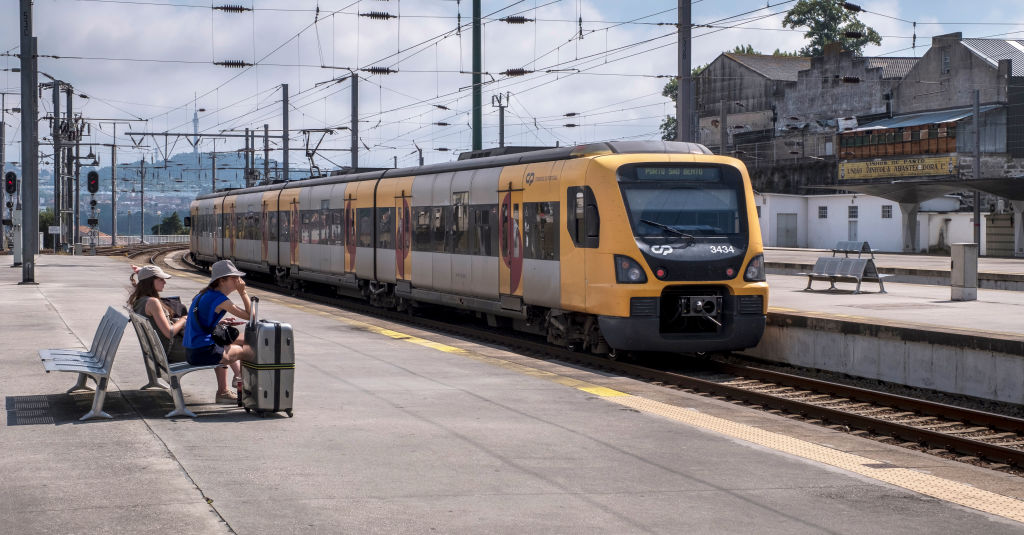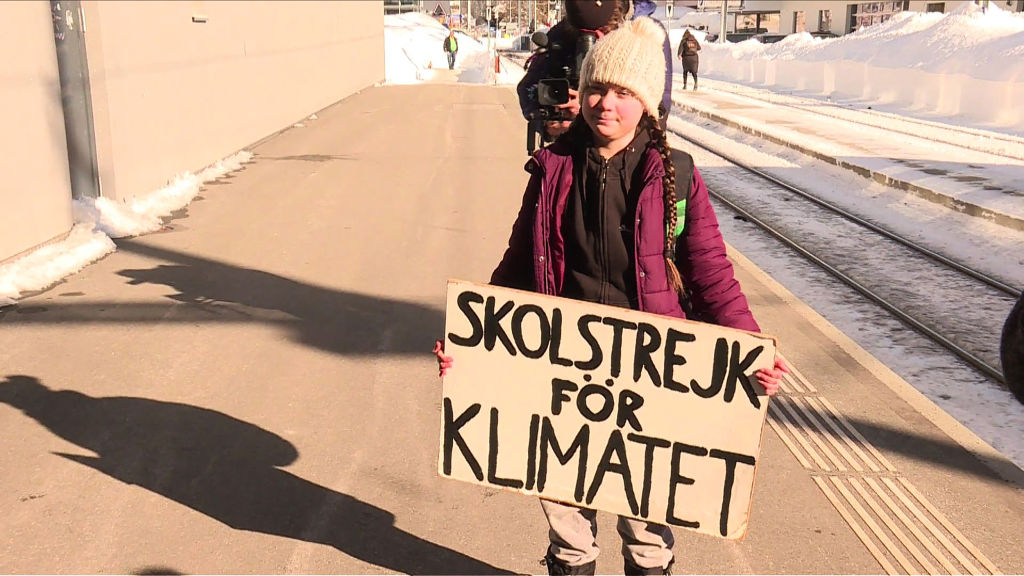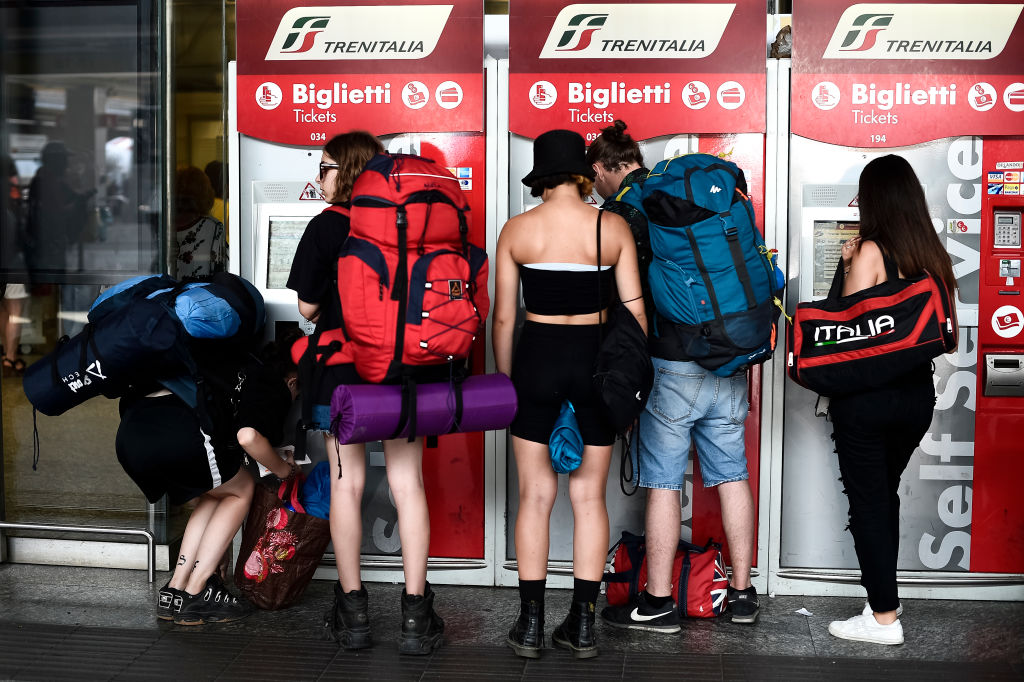
As a fairly reserved group, Scandinavians tend to be generally disinclined to chat to people they don’t know. But as the train for Berlin pulls out of Malmo station in southern Sweden late on a July afternoon during one of this summer’s many heatwaves, the atmosphere among the strangers seated in car 104 is almost festive. Mattias Berglund and Cathrine Hellberg, both in their 20s, chat easily—even giddily—with the four others in their seemingly 1970’s-era compartment, replete with faded velour seats and decidedly unairconditioned temperatures. Perhaps their conviviality was sparked by the close quarters, or by the 13-hour adventure ahead. Or perhaps it springs from a shared sense of mission. “We’re very concerned about the environment, and I felt guilty when we flew to Barcelona for our last holiday,” says Hellberg, a student, to nods all around. “I feel a little proud now to be taking the train.”
This is the season of flygskam, or “flight shame.” You don’t have to be Greta Thunberg, the teenage climate activist who recently announced plans to sail to New York in August, to recognize that a growing number of Europeans eager to reduce their carbon footprint are opting to limit air travel in favor of more environmentally-friendly means of transportation. Significant enough that even airlines are taking note, flygskam–and its counterpart tagskryt, or train-bragging—is encouraging both European governments and private rail companies to consider investing in the return of long-distance night trains. But the revival of a form of transport that has long seemed consigned to the pages of Agatha Christie novels poses significant obstacles of its own.
Leave it to northern Europeans to come up with a neologism to describe a complicated emotional state. As a concept, flygskam originated in Sweden, and refers both to the guilt that individuals may feel when using a means of transportation estimated to contribute between 2 and 3% of total atmospheric carbon and to the shaming they may face should they persist in flying. It was articulated by opera singer Malena Ernmann, who gave up flying in 2016 (and who just happens to be Thunberg’s mother), drawing the attention of other celebrities and the broader public to the cause. The summer of 2018, which brought record high temperatures to Sweden, and with them, devastating wildfires, drove the point home. “It had not been like this ever before,” says Marco Andersson, head of sales for Snålltåget, the Swedish rail company that runs the Malmo-Berlin line. “I think a lot of people started thinking, ‘Oh, I need to change my behavior, maybe I shouldn’t go on vacation to Thailand anymore.’”
Two grassroots initiatives, both launched that year, helped spread the word: Flygfritt, which convinced 14,500 Swedes to renounce air travel in 2019 (it’s shooting for 100,000 in 2020) and Tagsemester, a Facebook group with nearly 100,000 members, that offers information on how to travel by train. Throw in some selfies posted from the sleeping berth of the train Thunberg took to speak at the World Economic Forum in Davos in January, as well as European and national elections in which climate concerns played a decisive factor, and Sweden’s anti-plane, pro-rail movement has taken off.

For Snålltåget, which acquired the Malmo-Berlin line in 2011, the impact has been striking. “From 2012 to 2017 we didn’t make a profit,” says Andersson. “Every year, we were asking, why are we still in this business? But all that changed last summer.” During the first six months of 2019, the company, which also runs night trains between Malmo and Stockholm, and, in winter, to the ski town Åre, has seen a 20% increase in ticket sales. Meanwhile, flights between Malmo and Stockholm have declined 10% in the past year, and across Sweden, domestic flights on the whole have fallen 4.5% in the first quarter of 2019 compared to the previous year, according to SJ, the national rail company.
Yet Sweden isn’t the only place feeling the effects of flygskam (in fact, the Dutch, Germans, and Finns have their own words for it). Flygfritt now has chapters in the UK, France, and Germany and according to Eurail and Interrail General Manager Carlo Boselli, flygskam is influencing the decision to purchase the rail passes (which allow for cross-border travel anywhere on the continent) as well. “According to an internal survey we did,” Boselli says, “the low carbon footprint of rail travel was relevant in the decision about holiday transportation for 71% of Interrailers in 2019–nearly 20% more than in 2017.” The popularity of sites like the U.K.-based Seat61, which offers information on train travel in Europe, or the recent expansion of Omio, a Berlin-based booking platform that links train, bus, and air tickets, only underline this growing interest.
Europe’s largest international passenger rail company, the Austrian ÖBB, has seen a 10% growth this spring and summer over 2018 on some of its lines, including the ones that run from Vienna to Zurich, and Rome to Munich. Spokesman Bernhard Rieder cautions that, in high season, they could do much more. “During summer, there’s no room for us to increase ridership,” he says, “ because we’re already nearly fully booked. On a Saturday in July in Italy, we could be running three trains a night instead of one.”

It’s enough to make an airline executive nervous. Speaking before 150 of them at the annual meeting of the International Aviation Transport Association held in Seoul in May, director general Alexandre de Juniac warned of flygskam: “Unchallenged, this sentiment will grow and spread.”
So far, IATA has not noticed a drop in passengers, according to spokesperson Chris Goater. “But we don’t want to play down the importance of the debate. We’ve had targets for carbon for more than a decade–earlier than any other industry. From 2020, through capping and offsetting, our goal is to be carbon neutral. And from 2050, our goal is to reduce emissions 50% below 2005 levels.”
IATA hopes to achieve that more difficult goal through the development of sustainable fuels, and new technologies like electric planes, rather than by reducing the number of flights. “The enemy isn’t travel,” says Goater. “The enemy is carbon.” But it’s probably a telling sign of changing public sentiment that the Netherlands-based airline KLM recently launched a campaign, called “Fly Responsibly,” that among other measures, urges passengers to fly less often.
The idea that acting responsibly entails flying less is even spreading to the United States. A jet propulsion scientist at NASA started No Fly Climate Sci in 2017 as a platform for earth scientists who wanted to make public commitments to reducing their carbon footprints. Kim Cobb was one of the scientists to sign up. A few years ago, her research into the large-scale destruction of reefs prompted the professor of Atmospheric Sciences at the Georgia Institute of Technology to examine her own carbon footprint a few years ago. “I was gobsmacked at how large a portion—85%—was locked in from flying, mostly for professional meetings and conferences, and, some for field research. As a scientist, I couldn’t unsee those numbers.”
In 2018, Cobb managed to cut her flight miles by 75%, going from an average of 125,000-plus a year, to 25,000 or 30,000. The effort has come at some cost: “About half the invitations I receive to speak are withdrawn when I ask to present remotely or virtually,” she says. She still flies occasionally–as a member of the IACCP, for example, she is required to attend quarterly meetings—but she pays the full market price to offset the flights she does take. “That’s comes out to about $400 per metric ton of carbon, says Cobb, who, on the day she spoke to TIME was about to board a 22-hour train that would take her from her home in Atlanta to a symposium in Springfield, Massachusetts (a round-trip flight to the same destination would equal about a quarter of a ton). “If you’re going to get on a plane, perhaps you should have that number in your head.”
Still, even if they have the time and inclination to reduce their carbon footprint, travelers may find it difficult to choose a 16-hour, $145 train ticket from London to Barcelona, when a flight takes a little over two and can cost as little as $35. And in fact, it was the emergence of low-cost airlines like Easyjet and Ryanair in the mid-1990s that helped bring a near-end to the era of sleeping cars and couchettes. In 2009, the Swiss company SBB sold off all its night lines to ÖBB; Germany’s Deutsche Bahn followed suit in 2016. The state-owned Swedish rail company, SJ, sold its Malmo-Berlin line, in operation since 1909, in 2011.
As a result, few easy rail journeys between major European cities remain; the traveler who opts for that 16 journey from London to Barcelona will not only pay more for the privilege, but will have to change trains twice. For countries like France, which is currently considering banning short haul domestic flights, and Sweden, which recently committed over $5 million to developing international lines to various European cities, the lack of infrastructure poses a significant obstacle. (The U.S. suffers even more from a lack of investment in rail infrastructure, and it remains difficult for most Americans to overcome the lack of high-speed rail system and opt out of air or car travel.)
There’s still a long wait ahead for Europeans too. Austria’s OBB, for example, has commissioned 12 new trains, but they won’t be in operation until 2021. Denmark has plans to build the Fehmarn Belt Link, an 11-mile underwater tunnel that will cut the time it takes to travel from Copenhagen to Hamburg from five hours to two–but it will take an estimated 10 years to complete. And even after the Swedish government committed that money to developing night trains, the state-owned rail company, SJ, has said it is not willing to pursue them until the Fehmarn tunnel is completed. Determined to press ahead, the co-ruling Green party has said it may offer the lines out on tender.
Which means that those connections may fall to Snälltäget, which has to weigh whether the recent uptick is enduring. “Right now, there’s more demand than we can handle,” Andersson says. “Should we take on other lines? Should we modernize our fleet? I don’t think flygskam is a passing fad, but developing based on it is a risk, and we need to figure out how much risk we can take.”
Annika Thomsson, an educator from Stockholm who was traveling with her 17-year-old daughter Saga to a holiday in Montpellier, France, even Snälltäget’s outdated trains represent a necessary concern for the future . “I had already been feeling bad about all the flying I do for work,” Thomsson said, “Because I know that climate change is going to affect my children, and eventually my grandchildren. And when I proposed this holiday, Saga said she would only come if we went by train.”
All told, the journey to Montpellier would take them two full days, though they were breaking it up with stops in Berlin and Paris. Saga, who also has participated in the school strikes for climate, was excited by the adventure of it–the train boards a ferry in the Swedish town of Trelleborg, crosses the Baltic, then picks up the rails again in Sassnitz, Germany before continuing on to Berlin—and spent much of the crossing in the ship’s restaurant, enjoying the buffet and playing cards with her mom. She was concerned about whether she would be able to sleep on the Snälltäget—without air conditioning, temperatures on board were suffocatingly high. But she was convinced they had made the proper choice. “You don’t travel by train to show off or make others feel shame,” she said as she stood in line to brush her teeth in the compartment’s small washroom. “You do it because you want to do the right thing.”
Correction, Aug 6
The original version of this story misstated the name of the university where Kim Cobb works. It is the Georgia Institute of Technology, not Georgia Tech University.
More Must-Reads from TIME
- Why Biden Dropped Out
- Ukraine’s Plan to Survive Trump
- The Rise of a New Kind of Parenting Guru
- The Chaos and Commotion of the RNC in Photos
- Why We All Have a Stake in Twisters’ Success
- 8 Eating Habits That Actually Improve Your Sleep
- Welcome to the Noah Lyles Olympics
- Get Our Paris Olympics Newsletter in Your Inbox
Contact us at letters@time.com